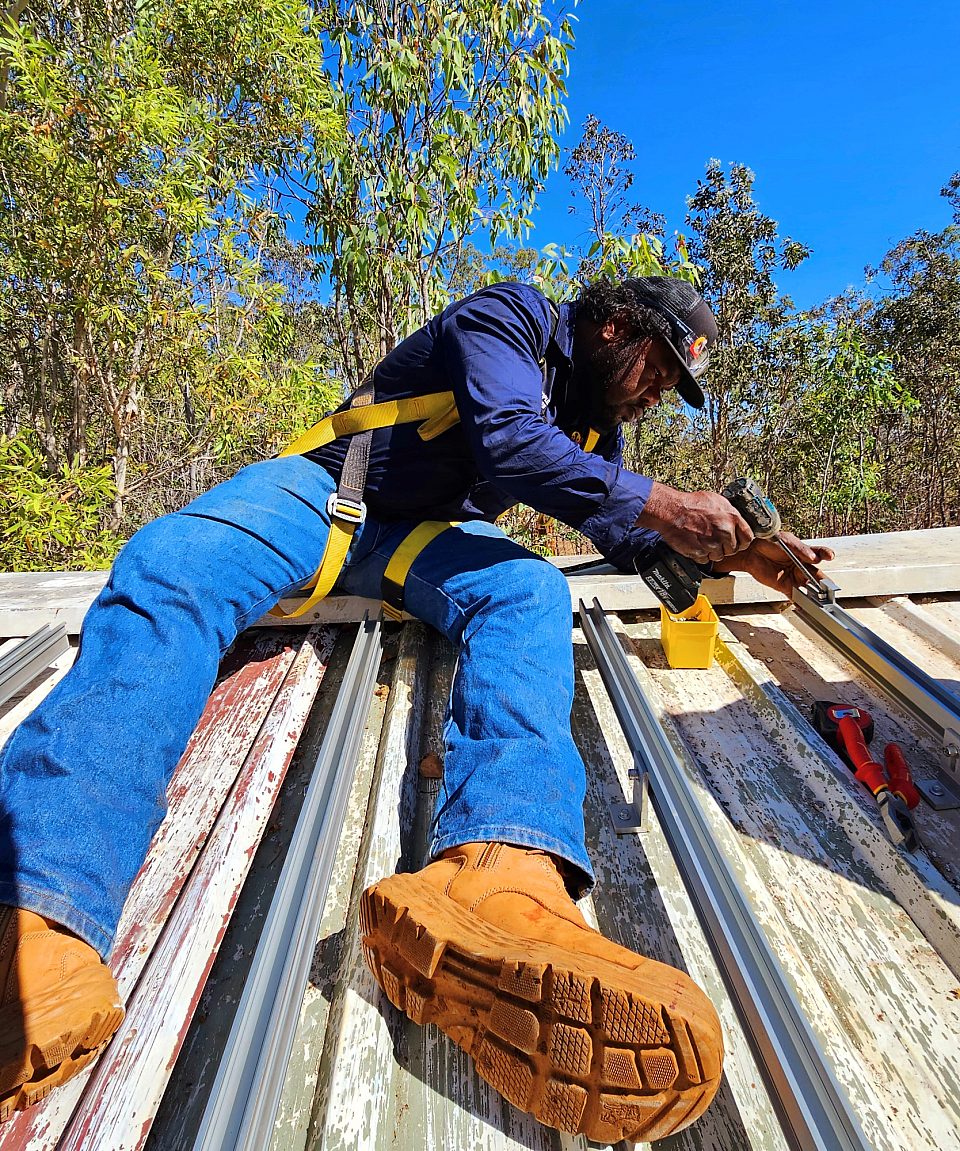
A small team of First Nations workers learned the basics of solar installation by powering a series of tiny homes with panels and batteries in an intensive five-day renewable energy program held earlier this month in Mataranka, Northern Territory.
The six participants from the remote communities of Borroloola, Marlinja and Mataranka were the first to trial a new collaborative hands-on training exercise run by Indigenous-led Original Power and engineering, procurement and construction provider, Next Generation Electrical (NGE).
The training covered health, safety and environment and electrical principles, installation of racking and rooftop solar panels, installing hardware such as charge controllers and switchboards, basic fault finding and load calculations, and how to work safely at heights and as part of a construction team.
As part of the program, participants also identified additional skills they need for employability in the renewable energy industry. Feedback confirmed participants’ positive experience of the training and led to plans for a wider roll-out.
Richard Collins from Marlinja said it was great to learn alongside other people, to come together and share ideas on how to do things better. “I can take this back to community and teach them how to build solar back home.”
This was echoed by Conrad Rory from Borroloola. “I learned a lot of new things and refreshed some of my learnings on the practical side about wiring, installing panels, working safely on a roof – it will help me for the future.
Inclusive, practical learning
Based on participants’ feedback, NGE is seeking to refine, then pilot, the program as a Certificate 2 in Renewable Energy Pathways, ready for delivery in the coming months to help individuals, including more First Nations people, enter the booming renewables industry.
Maddy Hickman from NGE says the training was designed to be as practical as possible. “We aimed to provide learners with the required skills and confidence to enter the renewable energy industry, while addressing the skills shortage we’re currently facing across the industry as a whole.
“It was a fantastic opportunity to trial it in Mataranka, seeing some of the units we have built come to life and take some key learnings back to further refine the program, while simultaneously seeing the impact that providing an inclusive and practical learning environment has on individuals and communities.”

Original Power’s Clean Energy Communities Project Coordinator Lauren Mellor says that at the moment, this sort of tailored introductory training is not available to most First Nations people and remote communities.
“The program is unique because it was designed using feedback from workers and community members looking to develop their own renewable energy projects. They nominated who should participate and identified the knowledge and skills to be covered based on the progress of their own community renewable energy projects, and their enthusiasm for ongoing work in the solar electrical industry. As a result of the training, participants will soon be ready to deploy solar in their own communities.”
The community in Borroloola are currently engaged in the design of their own 2.5 megawatt solar farm and battery project to be integrated with the Northern Territory Government-operated diesel power station. Their Ngardara ‘Sun’ Microgrid Project aims to reduce local energy costs and keep pre-paid meter customers connected to power, while generating an income stream for the community through the sale of electricity.
And having already solar-powered the local community centre to secure lower costs and clean energy, the Marlinja community is now working on the Marlinja Community Solar Project, an ambitious plan for the whole community to move to 100 per cent renewables and generate its own electricity from solar power with battery storage.
Both the Marlinja and Borroloola projects are moving through assessment with the assistance of Original Power and when completed, will be the first First Nations-owned community-scale renewable energy projects in the Northern Territory.
Training that reflects experience
Mellor says training local community members to address skills gaps in the renewable energy transition is necessary for the success of these projects.
“First Nations communities are used to training that doesn't lead to real-world jobs, or seeing external contractors take work that locals have capacity to complete, often more efficiently and cheaply than fly-in-fly-out arrangements. Communities want training that reflects their real-world experience in developing renewable energy projects, so we co-developed the pilot training program to learn how best to deliver it as an entry point for First Nations people to enter the renewable energy industry.
“Modules were delivered in real world scenarios, with lots of time for one-on-ones with trainers and the chance to create strong bonds with neighbouring communities experiencing the same energy challenges.”
As the training program combines both construction and renewable energy fundamentals, Hickman says it’s applicable to anyone wanting to enter the industry, or pivot from a construction background to renewables.
“While in the trial phase, the program will continue to be tested in a project-based environment, teaching learners how to build solar and work in the industry as skilled trades assistants. Once established, the program will be open to anyone wanting to learn more about and enter the renewable energy industry with a formal, nationally recognised qualification, providing job opportunities for individuals in various roles, and ensuring we have a sufficient workforce to fast-track our clean energy transition.”
Mellor says a job in solar means a job for life.
“People want to work in the renewable energy industry. They can see the application of this technology in solving everyday challenges including energy insecurity in their communities, and they see the potential for long-term careers with larger export scale projects currently in development. We're inundated with community members who want to get a leg-up in the renewable energy industry – the workforce of the future.”